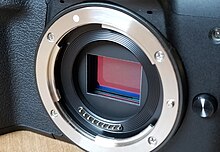
Back MILC Catalan Bezzrcadlovka Czech Systemkamera#Digitale Systemkameras German Cámara sin espejo de objetivos intercambiables Spanish Hübriidkaamera ET دوربین بدون آینه FA Peilitön järjestelmäkamera Finnish Appareil photographique hybride French मिररलेस कैमरा HI EVIL Italian


A mirrorless camera (sometimes referred to as a mirrorless interchangeable-lens camera (MILC)[1] or digital single-lens mirrorless (DSLM)) is a digital camera which, in contrast to DSLRs,[2] does not use a mirror in order to ensure that the image presented to the photographer through the viewfinder is identical to that taken by the camera. They have come to replace DSLRs, which have historically dominated interchangeable lens cameras.[3] Other terms include electronic viewfinder interchangeable lens (EVIL)[1][4] and compact system camera (CSC).[1][5]
Lacking a mirror system allows the camera to be smaller, quieter, and lighter.[6]
In cameras with mirrors, light from the lens is directed to either the image sensor or the viewfinder. This is done using a mechanical movable mirror which sits behind the lens.[7] By contrast, in a mirrorless camera, the lens always shines light onto the image sensor, and what the camera sees is displayed on a screen for the photographer. Some mirrorless cameras also simulate a traditional viewfinder using a small screen, known as an electronic viewfinder (EVF).[6]
DSLRs can act like mirrorless cameras if they have a "live view" mode, in which the mirror moves out of the way so the lens can always shine onto the image sensor.[8]
Many mirrorless cameras retain a mechanical shutter. Like a DSLR, a mirrorless camera accepts interchangeable lenses. Mirrorless cameras necessarily have shorter battery life because they need to power the screen and sensor at all times.[6]
- ^ a b c King, Julie Adair (2012). Digital Photography For Dummies. Hoboken: John Wiley & Sons. p. 18. ISBN 9781118092033. Retrieved February 18, 2024.
- ^ Teubner, Ulrich (2019). Optical imaging and photography : introduction to science and technology of optics, sensors and systems. Hans Josef Brückner. Berlin. ISBN 978-3-11-047293-6. OCLC 971349161.
{{cite book}}: CS1 maint: location missing publisher (link) - ^ Schneider, Jaron (February 24, 2021). "What If The 'Collapse' of the Camera Industry Was Based on Flawed Data?".
- ^ Speranza, Olivia (2012). The Moviemaking with Your Camera Field Guide: The Essential Guide to Shooting Video with HDSLRs and Digital Cameras. Lewes: Octopus. ISBN 9781781570449. OCLC 958105889.
- ^ Gatcum, Chris (2017). Complete Photography : Understand cameras to take, edit and share better photos. London. ISBN 978-1-78157-494-2. OCLC 982383206.
{{cite book}}: CS1 maint: location missing publisher (link) - ^ a b c Hein, Justin (September 8, 2022). "What is a Mirrorless Camera?".
- ^ "What is a DSLR Camera? DSLR vs. Mirrorless Cameras".
- ^ "What Is Live View and Why Should You Use it on Your DSLR?". Digital Trends. August 13, 2019. Retrieved August 5, 2023.